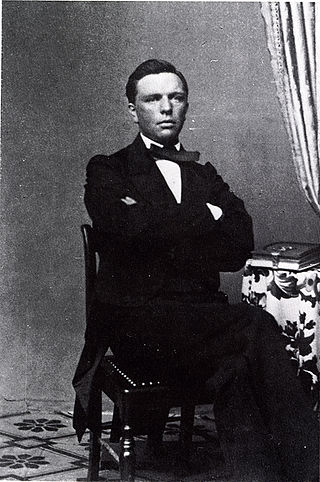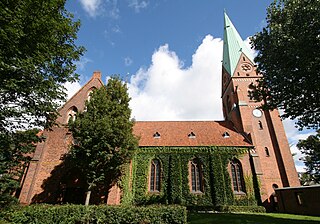
Caspar Frederik (Friedrich) Harsdorff, also known as C.F. Harsdorff, was a Danish neoclassical architect considered to have been the leading Danish architect in the late 18th century.

Martin Borch (1 March 1852 – 8 February 1937) was a Danish architect.

Georg Andreas Bull was a Norwegian architect and chief building inspector in Christiania for forty years. He was among the major architects in the country, and performed surveying studies and archeological research.

Peter Christian Bønecke was a Danish architect.

Gammel Kongevej is the principal shopping street of Frederiksberg in Copenhagen, Denmark. Running roughly parallel to Frederiksberg Allé and Vesterbrogade, it extends from Vesterport station at the southern end of The Lakes and continues for some 1.8 km west to Frederiksberg City Hall Square where it continues as Smallegade. In the opposite end, Jernbanegade connects it to Copenhagen City Hall Square.

The (A. N.) Hansen Mansion is a Neoclassical town house in the Frederiksstaden neighbourhood of central Copenhagen, Denmark. Completed in 1835 to designs by Jørgen Hansen Koch, it now houses a fashion innovation centre.

H. C. Ørsteds Vej is a street in the Frederiksberg district of Copenhagen, Denmark. It runs from Gammel Kongevej in the south to Åboulevard on the border with Nørrebro in the north, linking Alhambravej in the south with Griffenfeldsgade in the north.

Christian Frühstück Nielsen was a Danish architect born in Aarhus, Denmark on 7 August 1878. Frühstück Nielsen primarily worked in and around Aarhus and on Mors where he left numerous lasting works.

Henriette Marie Antonette Luplau was a Danish artist and educator, active in the women's movement. She conducted an art school for women in Copenhagen with her partner, artist Emilie Mundt.

The Church of the Deaf or Deaf People's Church is a church in Copenhagen, on Falkonergårdsvej in the Frederiksberg Municipality.

Philip Smidth was a prolific Danish architect in the late 19th and early 20th centuries. His works included, commercial properties, high-end apartment buildings, hotels and hospitals. He worked in the Historicist style. Two of his works, Liselund Ny Slot on the island of Møn and Gefion and Gylfe in Copenhagen, have been listed by the Danish Heritage Agency.

The Holy Cross Church is a Church of Denmark parish church located at the corner of Kapelvej and Hans Tavsens Gade in the Nørrebro district of Copenhagen, Denmark. The church was built in 1887–1890 to a National Romantic design by Hermann Baagøe Storck.
Tårnborgvej is a dead end street extending from the northside of Gammel Kongevej, one block East of H. C. Ørsteds Vej, in the Frederiksberg district of Copenhagen, Denmark.

Emil Vett was a Danish businessman who was a co-founder of Magasin du Nord.

Isaac Wulff Heyman was a Danish businessman and philanthropist. He was the elder half-brother of Tuborg Brewery founder Philip Heyman.
Henrik Larsen Kyhl was a Danish clockmaker, politician and the second managing director of Tivoli Gardens in Copenhagen.
The Danish Deaf Association is a private advocacy group which works to ensure better living conditions for deaf people in society. It campaigns for equality between deaf and hearing people in education, paid employment and accessibility, as well as the legal status and accessibility of Danish Sign Language.

Vodroffsvej 10 is one of several surviving 19th-century villas situated on the west side of St. Jørgen's Lake in the Frederiksberg district of central Copenhagen, Denmark. Built in 1865, it was one of three villas constructed in the area by master mason and architect Jørgen Wilhelm Frohne (1832-1909) for family members of the owner of nearby Vodroggsgård. An atelier in the garden was constructed in 1882 for the painter Laurits Tuxen, brother-in-law of the next owner and also a resident of the building. Other artists to have used the atelier include Julius Schultz, Hans Gyde Petersen and Daniel Hvidt. The house and atelier were both listed in the Danish registry of protected buildings and places in 1980. The neighboring villa at No. 8 was also constructed by Frohne and is also heritage listed. Bonnie Mürsch — a lawyer whose father purchased the house in 1940 and is herself still living in one of its three apartments — published a book about it in conjunction with its 150th anniversary in 2015.

Wilhelm Wanscer was a Danish paper merchant and art collector, remembered above all for his associations with the philosopher Søren Kirkegård and some of the leading Danish Golden Age artists. He was the father of surgeon Oscar Wanscher and industrialist Axel Wanscher, grandfather of art historian Vilhelm Wanscher and great-grandfather of the designer Ole Wanscher.

The Prior House, situated at Bredgade 33, opposite Sankt Annæ Plads, is the current headquarters of the Bruun Rasmussen auction house in Copenhagen, Denmark. The Neoclassical building was conjstructed in 1794 for a ship captain by master mason Andreas Hallander. It contained a single high-end apartment on each of the three upper floors. The building takes its name after businessman and ship-owner Hans Peter Prior, its owner from 1850 until his death 25 years later, whose shipping company DFDS was initially based in the building. One of Prior's sons was the sculptor Lauritz Prior. In 1864, Prior charged the architect Wilhelm Petersen with the design of a three-storey atalier building for the son. Prior's Atelier Building is decorated with a series of reliefs created by Lauritz Prior. It was after his death used by a number of other leading Danish artists of the late 19th and early 20th century, including Peder Severin Krøyer, Lauritz Tuxen, Carl Bloch, Frants Henningsen and Edvard Weie. Kunstnernes Frie Studieskoler, an art school founded by Krøyer and Tuxen as an alternative to that of the Royal Danish Academy of Fine Arts, was initially based in the building. The Prior House remained in the hands of the Prior family for almost one hundred years. In 1847, Bredgade 33 was acquired by Bruubn Rasmussen-founder Arne Bruun Rasmussen, whose auction house has since then been headquartered in the building. Other notable former residents include the naval officers Johann Christopher Hoppe, Jost van Dockum and Edouard van Dockum, government officials Johann Paul Høpp and Friedrich Nicolaus von Liliencron, writer Adam Oehlenschläger and politician Orla Lehmann.


















